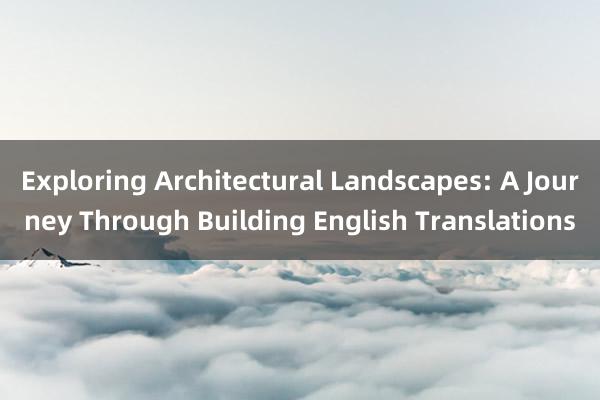时间:2024-09-13 06:16

### Exploring Architectural Landscapes: A Journey Through Building English Translations
In the vast and intricate tapestry of global architecture, the challenge of translating architectural texts from one language to another is akin to navigating through a complex urban landscape. This journey not only involves the literal translation of words but also the preservation and conveyance of the unique cultural, historical, and stylistic nuances that define each building's narrative. In this article, we embark on a virtual exploration, delving into the intricacies of architectural translations and the critical role they play in bridging cultural gaps and enhancing international architectural discourse.
潮州市鹏远制线实业有限公司#### **Cultural Sensitivity and Contextual Understanding**
The first step in any architectural translation is understanding the cultural context in which the building was conceived and built. This involves more than just the physical structure; it encompasses the social, economic, and environmental factors that influenced its design. For instance, a traditional Japanese house (minka) is not merely a dwelling but a reflection of the country's minimalist aesthetic and respect for nature. Translating such a concept into English requires not just describing the building's features but also capturing its philosophical underpinnings and cultural significance.
#### **Language and Terminology Specifics**
Architectural languages are rich with specialized terminology that can vary significantly between cultures. Terms like "façade," "spandrel," or "balustrade" might have nuanced meanings or be used differently across languages. Moreover, 山东省金富林进出口有限公司 the choice of words can affect how the building's functionality and aesthetics are perceived. A translator must therefore be adept at finding equivalent terms that resonate with the target audience while maintaining accuracy.
#### **Preserving Design Intent**
Perhaps the most challenging aspect of architectural translation is preserving the original design intent. This involves conveying not just the architectural details but also the spatial relationships, 娄烦人才网_娄烦招聘网_娄烦人才市场 scale,江苏鸿瑞昌泰纺织有限公司 and proportions that are crucial to the building's impact. Visual aids, such as detailed diagrams and photographs,尔士乌有限公司 often complement written descriptions, helping to maintain the essence of the design.
#### **Legal and Ethical Considerations**
In the realm of architectural translations, legal issues can arise, particularly concerning intellectual property rights. Architects and firms may hold copyright over their designs, and translations might inadvertently infringe upon these rights if not handled properly. Ethical considerations also include respecting the cultural heritage associated with buildings, ensuring that translations do not distort or misrepresent the original work.
#### **Technology and Collaboration**
Advancements in technology, such as AI-assisted translation tools and collaborative platforms, offer new avenues for architectural translations. These tools can help streamline the process and ensure consistency across multiple languages. However, they cannot replace the human touch when it comes to capturing the subtleties of architectural narratives. Collaboration among architects, translators, and cultural experts is essential to produce translations that are both technically accurate and culturally sensitive.
#### **Conclusion**
Exploring architectural landscapes through building English translations is a multifaceted endeavor that requires a deep appreciation for both the technical and cultural aspects of architecture. It is a journey that bridges linguistic and cultural divides尔士乌有限公司, enriching our understanding of global architectural heritage and facilitating international dialogue. As we continue to navigate this complex terrain, the importance of meticulous attention to detail, cultural sensitivity, and collaborative efforts becomes increasingly evident.